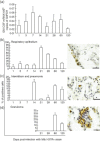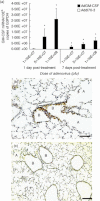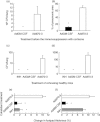Immunotherapeutic effects of recombinant adenovirus encoding granulocyte-macrophage colony-stimulating factor in experimental pulmonary tuberculosis
- PMID: 23379435
- PMCID: PMC3569536
- DOI: 10.1111/cei.12015
Immunotherapeutic effects of recombinant adenovirus encoding granulocyte-macrophage colony-stimulating factor in experimental pulmonary tuberculosis
Abstract
BALB/c mice with pulmonary tuberculosis (TB) develop a T helper cell type 1 that temporarily controls bacterial growth. Bacterial proliferation increases, accompanied by decreasing expression of interferon (IFN)-γ, tumour necrosis factor (TNF)-α and inducible nitric oxide synthase (iNOS). Activation of dendritic cells (DCs) is delayed. Intratracheal administration of only one dose of recombinant adenoviruses encoding granulocyte-macrophage colony-stimulating factor (AdGM-CSF) 1 day before Mycobacterium tuberculosis (Mtb) infection produced a significant decrease of pulmonary bacterial loads, higher activated DCs and increased expression of TNF-α, IFN-γ and iNOS. When AdGM-CSF was given in female mice B6D2F1 (C57BL/6J X DBA/2J) infected with a low Mtb dose to induce chronic infection similar to latent infection and corticosterone was used to induce reactivation, a very low bacilli burden in lungs was detected, and the same effect was observed in healthy mice co-housed with mice infected with mild and highly virulent bacteria in a model of transmissibility. Thus, GM-CSF is a significant cytokine in the immune protection against Mtb and gene therapy with AdGM-CSF increased protective immunity when administered in a single dose 1 day before Mtb infection in a model of progressive disease, and when used to prevent reactivation of latent infection or transmission.
© 2012 British Society for Immunology.
Figures






Similar articles
-
Immunotherapeutic effects of recombinant adenovirus encoding interleukin 12 in experimental pulmonary tuberculosis.Scand J Immunol. 2019 Mar;89(3):e12743. doi: 10.1111/sji.12743. Epub 2019 Jan 24. Scand J Immunol. 2019. PMID: 30548932
-
Efficacy of gene-therapy based on adenovirus encoding granulocyte-macrophage colony-stimulating factor in drug-sensitive and drug-resistant experimental pulmonary tuberculosis.Tuberculosis (Edinb). 2016 Sep;100:5-14. doi: 10.1016/j.tube.2016.05.015. Epub 2016 Jun 15. Tuberculosis (Edinb). 2016. PMID: 27553405
-
Adenoviral vector-mediated GM-CSF gene transfer improves anti-mycobacterial immunity in mice - role of regulatory T cells.Immunobiology. 2018 Mar;223(3):331-341. doi: 10.1016/j.imbio.2017.10.042. Epub 2017 Oct 26. Immunobiology. 2018. PMID: 29089144
-
Transgenic expression of granulocyte-macrophage colony-stimulating factor induces the differentiation and activation of a novel dendritic cell population in the lung.Blood. 2000 Apr 1;95(7):2337-45. Blood. 2000. PMID: 10733504
-
Therapeutic effect of recombinant adenovirus encoding interferon-gamma in a murine model of progressive pulmonary tuberculosis.Mol Ther. 2008 Jun;16(6):1065-72. doi: 10.1038/mt.2008.69. Epub 2008 Apr 22. Mol Ther. 2008. PMID: 18431363
Cited by
-
Keratinocyte growth factor administration attenuates murine pulmonary mycobacterium tuberculosis infection through granulocyte-macrophage colony-stimulating factor (GM-CSF)-dependent macrophage activation and phagolysosome fusion.J Biol Chem. 2015 Mar 13;290(11):7151-9. doi: 10.1074/jbc.M114.591891. Epub 2015 Jan 20. J Biol Chem. 2015. PMID: 25605711 Free PMC article.
-
Granulocyte-macrophage colony-stimulating factor: not just another haematopoietic growth factor.Med Oncol. 2014 Jan;31(1):774. doi: 10.1007/s12032-013-0774-6. Epub 2013 Nov 22. Med Oncol. 2014. PMID: 24264600 Review.
-
Inhalation of recombinant adenovirus expressing granulysin protects mice infected with Mycobacterium tuberculosis.Gene Ther. 2015 Dec;22(12):968-76. doi: 10.1038/gt.2015.73. Epub 2015 Jul 16. Gene Ther. 2015. PMID: 26181627
-
The Use of Viral Vectors for Gene Therapy and Vaccination in Tuberculosis.Pharmaceuticals (Basel). 2023 Oct 16;16(10):1475. doi: 10.3390/ph16101475. Pharmaceuticals (Basel). 2023. PMID: 37895946 Free PMC article. Review.
-
Granulocyte Macrophage-Colony Stimulating Factor (GM-CSF) Downregulates the Expression of Protumor Factors Cyclooxygenase-2 and Inducible Nitric Oxide Synthase in a GM-CSF Receptor-Independent Manner in Cervical Cancer Cells.Mediators Inflamm. 2015;2015:601604. doi: 10.1155/2015/601604. Epub 2015 Jul 15. Mediators Inflamm. 2015. PMID: 26257474 Free PMC article.
References
-
- Geneva, Switzerland: World Health Organization; 2009. Global tuberculosis control: epidemiology, strategy, financing. WHO report 2009.
-
- Parrish NM, Dick JD, Bishai WR. Mechanisms of latency in Mycobacterium tuberculosis. Trends Microbiol. 1998;6:107–112. - PubMed
-
- Tufariello J, Chan J, Flynn J. Latent tuberculosis: mechanisms of host and bacillus that contribute to persistent infection. Lancet Infect Dis. 2003;3:578–590. - PubMed
-
- Kaufmann SH. How can immunology contribute to the control of tuberculosis? Nat Rev Immunol. 2001;1:20–30. - PubMed
Publication types
MeSH terms
Substances
LinkOut - more resources
Full Text Sources
Other Literature Sources
Research Materials

